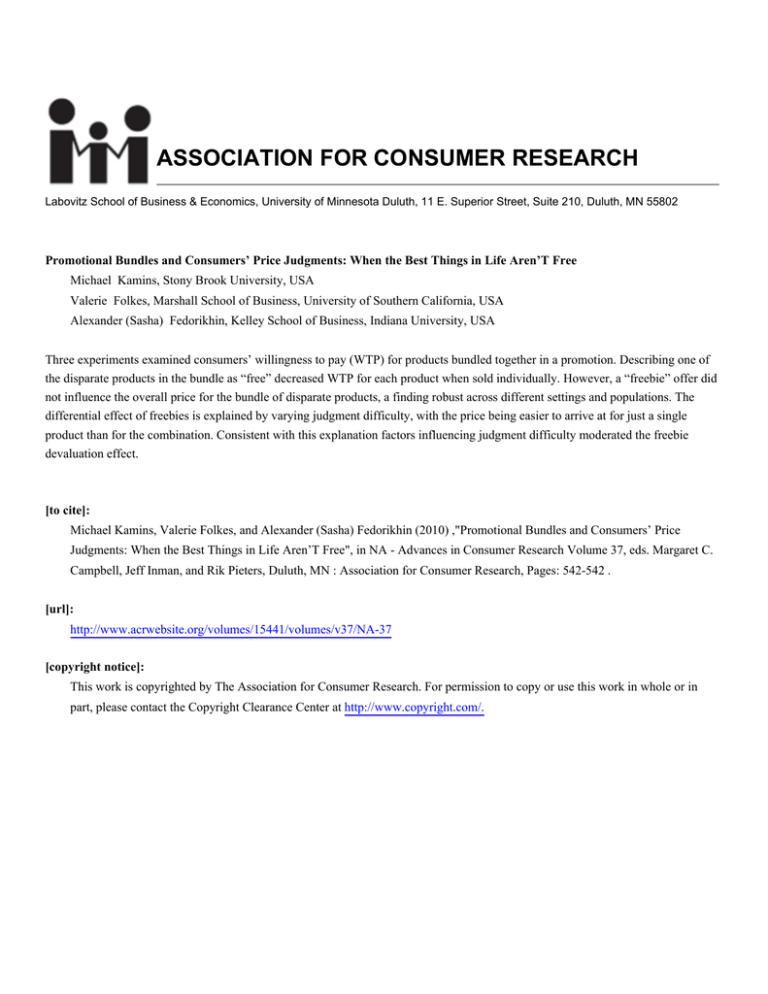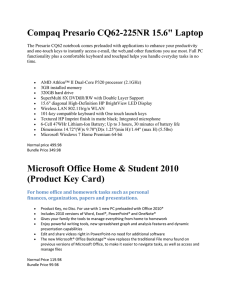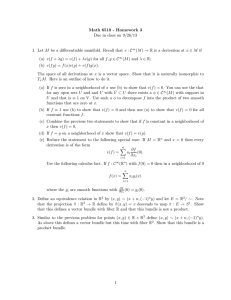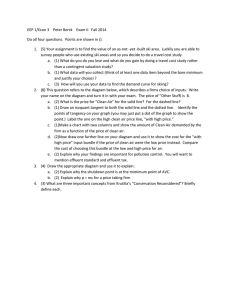Promotional Bundles and Consumers` Price Judgments: When the
advertisement

ASSOCIATION FOR CONSUMER RESEARCH Labovitz School of Business & Economics, University of Minnesota Duluth, 11 E. Superior Street, Suite 210, Duluth, MN 55802 Promotional Bundles and Consumers’ Price Judgments: When the Best Things in Life Aren’T Free Michael Kamins, Stony Brook University, USA Valerie Folkes, Marshall School of Business, University of Southern California, USA Alexander (Sasha) Fedorikhin, Kelley School of Business, Indiana University, USA Three experiments examined consumers’ willingness to pay (WTP) for products bundled together in a promotion. Describing one of the disparate products in the bundle as “free” decreased WTP for each product when sold individually. However, a “freebie” offer did not influence the overall price for the bundle of disparate products, a finding robust across different settings and populations. The differential effect of freebies is explained by varying judgment difficulty, with the price being easier to arrive at for just a single product than for the combination. Consistent with this explanation factors influencing judgment difficulty moderated the freebie devaluation effect. [to cite]: Michael Kamins, Valerie Folkes, and Alexander (Sasha) Fedorikhin (2010) ,"Promotional Bundles and Consumers’ Price Judgments: When the Best Things in Life Aren’T Free", in NA - Advances in Consumer Research Volume 37, eds. Margaret C. Campbell, Jeff Inman, and Rik Pieters, Duluth, MN : Association for Consumer Research, Pages: 542-542 . [url]: http://www.acrwebsite.org/volumes/15441/volumes/v37/NA-37 [copyright notice]: This work is copyrighted by The Association for Consumer Research. For permission to copy or use this work in whole or in part, please contact the Copyright Clearance Center at http://www.copyright.com/. Promotional Bundles and Consumers’ Price Judgments: When the Best Things in Life Aren’t Free Michael Kamins, Stony Brook University, USA Valerie Folkes, University of Southern California, USA Alexander (Sasha) Fedorikhin, Indiana University, USA EXTENDED ABSTRACT. The literature on pricing and promotions suggests that when a “free” product is bundled together with another product and offered for one price, consumers are willing to pay less for the “free” product when it is sold alone (Raghubir 2004). Our research shows that freebie also devalues the focal more expensive product in the bundle. With respect to the bundle as a whole, we show that the freebie devaluation effect does not occur unless the consumer is prompted to think about why a company would offer a product for free or the task is simplified by providing a bundle comprised of two identical items. Because valuation of a bundle of two disparate products demands cognitive resources and consumers tend to conserve those resources, valuations of bundles with freebies can be similar to valuations of bundles that lack the “freebie” designation. Our conceptual framework expands on previous pricing research by integrating recent insights about knowledge systems with the principles that the nature of the task and the consumers’ cognitive resources influence judgments, and that shifts between knowledge systems are effortful. The valuation task can involve at least two systems of knowledge, a numerical system and an inferential system. Shifts from one system to another are effortful, which favors the numerical system since consumers focus on the numerical system when they need to generate a price. When the judgment task is difficult, consumers tend to conserve mental resources through information selectivity. The valuation of a bundle is more difficult than the valuation for each of the disparate individual products comprising the bundle. Hence, freebies can lower the amount a consumer is willing to pay (WTP) for the individual products comprising the bundle without lowering WTP for the overall bundle price. Three experiments examined consumers’ judgments about WTP for the focal product and for the overall bundle when the bundle included a freebie. The first study was conducted in the field with online auction bidders on eBay. The second and third studies were laboratory experiments that offered a more controlled setting in which to test effects of the free designation when the difficulty in arriving at a WTP judgment varies. Study 1 conducted in the field showed that the final auction price for the focal product differed depending on the type of bundle sold concurrently. The focal product (the moderately expensive Indian penny coin) sold alone concurrently with a free bundle realized a lower price than when sold concurrently with a non-free bundle (Mfree=$3.77, SD=1.49, n=25, vs. Mnon-free=$4.67, SD=1.54, n=25), (t(48)= 2.09, p<.05). Consistent with our theorizing, there was no difference between the final price realized at the end of the auction in the free versus non-free condition for the mixed bundle (Mnon-free=$4.47; SD=1.34; n=45, vs. Mfree=$4.25, SD=1.73, n=45, NS). Study 2 conducted in the lab with shampoo and conditioner used as parts of a mixed bundle manipulated whether or not the supplemental item (conditioner) was free (free vs. no mention of free) and the type of judgment required (price for the focal product from the mixed bundle, price for the mixed bundle, and price for the homogeneous bundle consisting of two bottles of shampoo). The results show freebie devaluation effect for the focal product and the homogeneous bundle, but not for the mixed bundle, suggesting that WTP for a bundle varies depending on the resources available for making inferences about the free offer. The lack of difference between the mixed bundle prices is consistent with our notion that the cognitive demands of the task deter respondents from taking into account negative inferences when arriving at the total bundle price. When the WTP task itself required fewer resources (e.g., as in a homogeneous bundle), describing one item as free reduced the price respondents were willing to pay for the bundle as a whole. We conducted Study 3 in the lab with the same stimuli, manipulating motive salience for offering a free product (salience present vs. salience absent), the availability of resources for making judgments (time pressure vs. no time pressure), and the type of judgment required (focal product vs. overall bundle). Only freebie bundles were used in study 3. Consistent with our theorizing, making motives salient had no effect on focal product WTP when time was unlimited (Msalience present=$2.95 vs. Msalience absent=$3.03), but resulted in lower WTP when time was limited (Msalience present=$3.30 vs. Msalience absent=$4.16). Focal product valuation is a fairly simple task that does not require a lot of cognitive resources. Hence, consumers make inferences about company’s motives for the freebie promotion, even when the motive is not made salient. Under time pressure, making the motive salient helps them incorporate it in their WTP. Unlike focal product conditions, making motives salient lead to lower overall bundle WTP when time was unlimited (Msalience present=$3.79 vs. Msalience absent=$4.92). Salience had no effect on WTP when time was limited (Msalience present=$5.03 vs. Msalience absent=$4.87). Mixed bundle valuation is a relatively more difficult task, which means that making the motive salient only helps consumer incorporate this knowledge into their WTP if there is no time pressure. Under time pressure, the task becomes simply too difficult, and even making motive for the promotion salient is not sufficient to help consumers incorporate it into their judgments. Consistent with our reasoning, the number of negative thoughts about the product mediated the effect of the three-way interaction on WTP. REFERENCES Raghubir, Priya (2004), “Free Gift with Purchase: Promoting or Discounting the Brand,” Journal of Consumer Psychology, 14 (1-2), 181-86. 542 Advances in Consumer Research Volume 37, © 2010






